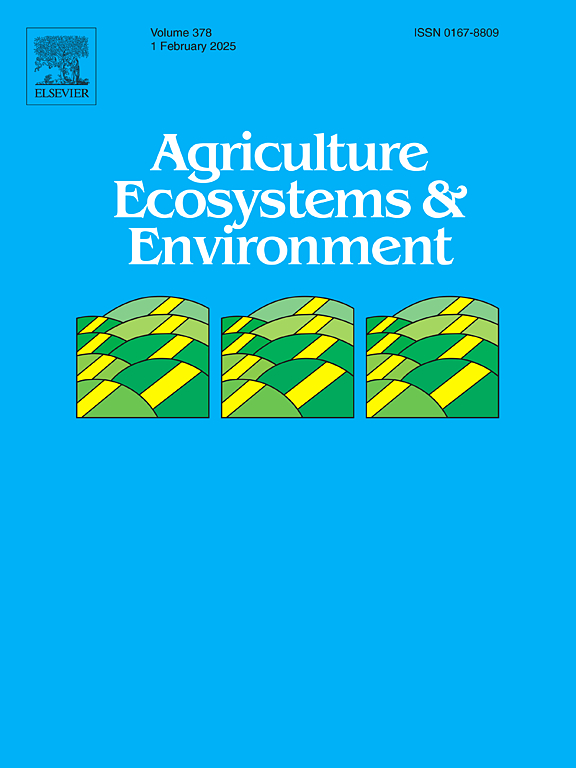Precipitation and grazing intensity jointly shape plant compensatory growth and productivity in a semi-arid steppe ecosystem
IF 6.4
1区 农林科学
Q1 AGRICULTURE, MULTIDISCIPLINARY
引用次数: 0
Abstract
Plant compensatory growth and productivity under animal grazing and their relations with climate have been one of the central topics in the ecology of natural grasslands. However, no consistent and general framework exists for the relationships of plant compensatory growth with grazing intensity and precipitation, especially in the semi-arid steppes of central Asia. We studied plant aboveground net primary productivity (ANPP) and compensatory growth (CG) of a semi-arid typical steppe grassland under different experimental grazing intensities, and over six years that were hugely variable with respect to precipitation in central Inner Mongolia (China). The grazing experiment used a random block-design consisting of four grazing intensities of nil (NG), light (LG), moderate (MG) and heavy grazing (HG), and replicated in four blocks. We found that (i) grazing with a defoliation rate ranging from 20 % (LG) to 60 % (HG) induced a plant over-compensatory growth, which significantly increased grassland ANPP, though the HG grassland showed a significantly lower potential production of plant aboveground biomass (AGBp, i.e., peak AGB of the grazed grassland but not subject to grazing in the measurement year) than the NG grassland. (ii) Precipitation and grazing intensity interactively determined plant growth and production. Plant over-compensatory growth and ANPP showed a humpback curve on the grazing gradient, and grazing intensity with the highest over-compensatory growth and ANPP increased with annual precipitation. (iii) Plant community over-compensatory growth under grazing was mostly attributed to over-compensatory growth of dominant species Leymus chinensis and some subordinate annual species, while the C4 grass Cleistogenes squarrosa had an under-compensatory growth at HG intensity. (iv) Precipitation enhanced grassland ANPP by promoting both AGBp and the over-compensatory growth after grazing. Our study demonstrates a framework showing the interrelations of plant compensatory growth or ANPP with grazing intensity and annual precipitation, which has important implications for the development of sustainable grassland management systems to adapt to climate and land use changes.
降水和放牧强度共同影响半干旱草原生态系统植物的补偿性生长和生产力
动物放牧条件下植物的补偿性生长和生产力及其与气候的关系一直是天然草地生态学研究的核心问题之一。然而,对于放牧强度和降水对植物补偿性生长的影响,特别是中亚半干旱草原的植物补偿性生长的影响还没有统一的总体框架。以内蒙古中部半干旱典型草原为研究对象,研究了不同放牧强度下植物地上净初级生产力(ANPP)和补偿生长(CG)的变化规律。放牧试验采用随机区组设计,包括零(NG)、轻度(LG)、中度(MG)和重度(HG) 4种放牧强度,在4个区组重复。研究发现:(1)在20 % (LG) ~ 60 % (HG)范围内的放牧引起了植物的过度代偿生长,显著增加了草地的ANPP,尽管HG草地的植物地上生物量潜在产量(AGBp,即测量年未放牧草地的AGB峰值)显著低于NG草地。(ii)降水和放牧强度相互作用决定植物生长和生产。植被过度补偿生长和ANPP在放牧梯度上呈座头曲线,且随着年降水量的增加,过度补偿生长和ANPP最高的放牧强度呈增加趋势。(3)放牧条件下植物群落的过度补偿生长主要表现为优势种羊草和部分次级一年生种的过度补偿生长,而C4禾草方闭草在HG强度下的过度补偿生长。(iv)降水通过促进AGBp和放牧后的过度代偿生长来增强草地ANPP。我们的研究展示了植物补偿性生长(ANPP)与放牧强度和年降水量之间相互关系的框架,这对发展适应气候和土地利用变化的可持续草地管理系统具有重要意义。
本文章由计算机程序翻译,如有差异,请以英文原文为准。
求助全文
约1分钟内获得全文
求助全文
来源期刊

Agriculture, Ecosystems & Environment
环境科学-环境科学
CiteScore
11.70
自引率
9.10%
发文量
392
审稿时长
26 days
期刊介绍:
Agriculture, Ecosystems and Environment publishes scientific articles dealing with the interface between agroecosystems and the natural environment, specifically how agriculture influences the environment and how changes in that environment impact agroecosystems. Preference is given to papers from experimental and observational research at the field, system or landscape level, from studies that enhance our understanding of processes using data-based biophysical modelling, and papers that bridge scientific disciplines and integrate knowledge. All papers should be placed in an international or wide comparative context.
 求助内容:
求助内容: 应助结果提醒方式:
应助结果提醒方式:


